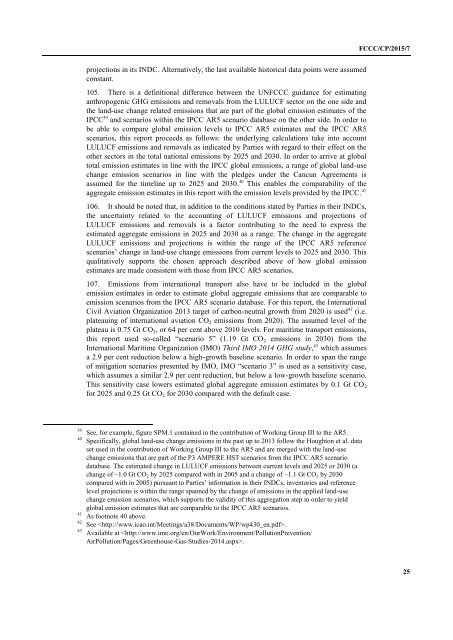FCCC/CP/2015/7
1PYuHQM
1PYuHQM
You also want an ePaper? Increase the reach of your titles
YUMPU automatically turns print PDFs into web optimized ePapers that Google loves.
<strong>FCCC</strong>/<strong>CP</strong>/<strong>2015</strong>/7<br />
projections in its INDC. Alternatively, the last available historical data points were assumed<br />
constant.<br />
105. There is a definitional difference between the UN<strong>FCCC</strong> guidance for estimating<br />
anthropogenic GHG emissions and removals from the LULUCF sector on the one side and<br />
the land-use change related emissions that are part of the global emission estimates of the<br />
IPCC 39 and scenarios within the IPCC AR5 scenario database on the other side. In order to<br />
be able to compare global emission levels to IPCC AR5 estimates and the IPCC AR5<br />
scenarios, this report proceeds as follows: the underlying calculations take into account<br />
LULUCF emissions and removals as indicated by Parties with regard to their effect on the<br />
other sectors in the total national emissions by 2025 and 2030. In order to arrive at global<br />
total emission estimates in line with the IPCC global emissions, a range of global land-use<br />
change emission scenarios in line with the pledges under the Cancun Agreements is<br />
assumed for the timeline up to 2025 and 2030. 40 This enables the comparability of the<br />
aggregate emission estimates in this report with the emission levels provided by the IPCC. 41<br />
106. It should be noted that, in addition to the conditions stated by Parties in their INDCs,<br />
the uncertainty related to the accounting of LULUCF emissions and projections of<br />
LULUCF emissions and removals is a factor contributing to the need to express the<br />
estimated aggregate emissions in 2025 and 2030 as a range. The change in the aggregate<br />
LULUCF emissions and projections is within the range of the IPCC AR5 reference<br />
scenarios’ change in land-use change emissions from current levels to 2025 and 2030. This<br />
qualitatively supports the chosen approach described above of how global emission<br />
estimates are made consistent with those from IPCC AR5 scenarios.<br />
107. Emissions from international transport also have to be included in the global<br />
emission estimates in order to estimate global aggregate emissions that are comparable to<br />
emission scenarios from the IPCC AR5 scenario database. For this report, the International<br />
Civil Aviation Organization 2013 target of carbon-neutral growth from 2020 is used 42 (i.e.<br />
plateauing of international aviation CO 2 emissions from 2020). The assumed level of the<br />
plateau is 0.75 Gt CO 2 , or 64 per cent above 2010 levels. For maritime transport emissions,<br />
this report used so-called “scenario 5” (1.19 Gt CO 2 emissions in 2030) from the<br />
International Maritime Organization (IMO) Third IMO 2014 GHG study, 43 which assumes<br />
a 2.9 per cent reduction below a high-growth baseline scenario. In order to span the range<br />
of mitigation scenarios presented by IMO, IMO “scenario 3” is used as a sensitivity case,<br />
which assumes a similar 2.9 per cent reduction, but below a low-growth baseline scenario.<br />
This sensitivity case lowers estimated global aggregate emission estimates by 0.1 Gt CO 2<br />
for 2025 and 0.25 Gt CO 2 for 2030 compared with the default case.<br />
39 See, for example, figure SPM.1 contained in the contribution of Working Group III to the AR5.<br />
40 Specifically, global land-use change emissions in the past up to 2013 follow the Houghton et al. data<br />
set used in the contribution of Working Group III to the AR5 and are merged with the land-use<br />
change emissions that are part of the P3 AMPERE HST scenarios from the IPCC AR5 scenario<br />
database. The estimated change in LULUCF emissions between current levels and 2025 or 2030 (a<br />
change of –1.0 Gt CO 2 by 2025 compared with in 2005 and a change of –1.1 Gt CO 2 by 2030<br />
compared with in 2005) pursuant to Parties’ information in their INDCs, inventories and reference<br />
level projections is within the range spanned by the change of emissions in the applied land-use<br />
change emission scenarios, which supports the validity of this aggregation step in order to yield<br />
global emission estimates that are comparable to the IPCC AR5 scenarios.<br />
41 As footnote 40 above.<br />
42 See .<br />
43 Available at .<br />
25


